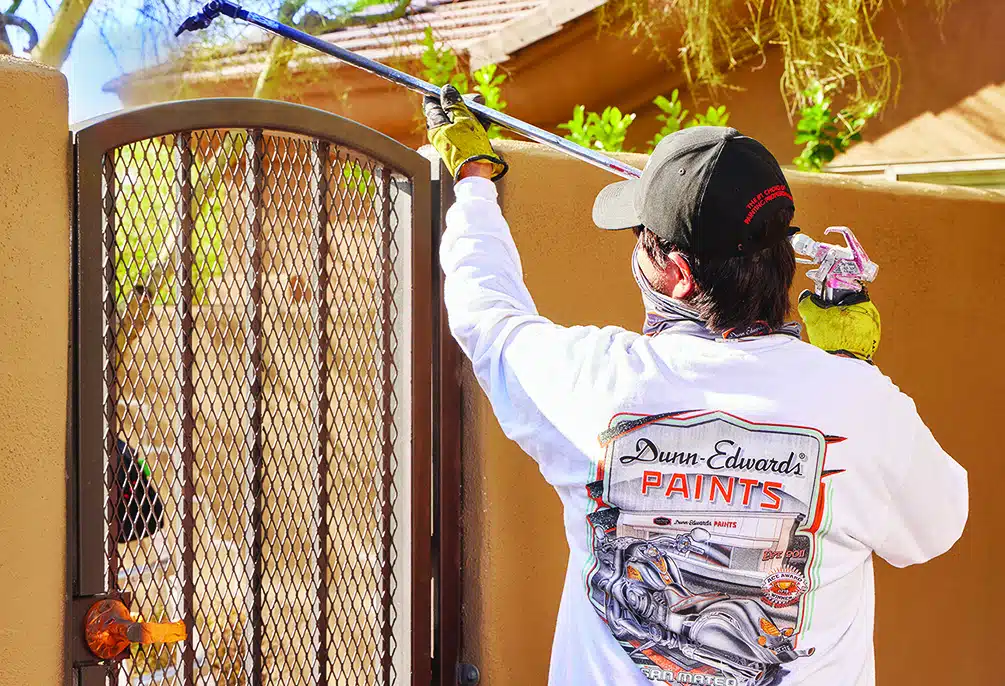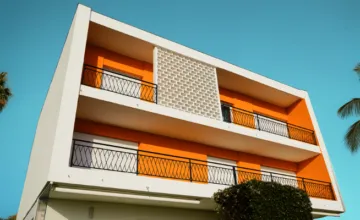Painting Galvanized Steel
12/04/2015 | Dunn Edwards |

What is Galvanization?
Have you ever wondered why certain metals in the environment appear to be impervious to corrosion? These silvery, spangled metals seem to withstand the test of time, resisting corrosion without any protective coating applied. The truth is, there is a protective coating on the metal – a protective layer of zinc (Zn) has been applied through a process called galvanization. In the simplest terms, the zinc has been applied to the base steel through a process called “Hot Dip Galvanizing” or “Immersion Galvanizing”. The purpose of the zinc immersion is purely for preservation of the steel. Not only does the zinc coating protect the steel by creating a barrier, but it also serves as a sacrificial anode in the event the bare steel is exposed to the environment through a scratch or break in the zinc. Galvanization protects the steel in the same fashion a zinc anode or plate protects the submerged portion of a boat motor – through sacrificial protection.
The Galvanization Process
The most common process for galvanizing steel is through the hot dip or immersion method. The fabricated steel will go through a series of steps resulting in a complete coating of heavy zinc. We refer to this kind of galvanizing as batch galvanizing or after-fabrication, heavy duty galvanizing. This process results in the highest level of protection and is commonly specified for highly corrosive interior and exterior environments.
The process begins with surface preparation and the complete removal of all oxides and other surface contaminants. This can be achieved first through solvent cleaning (SSPC-SP1) and abrasive blasting and/or caustic cleaning. After the steel receives a caustic cleaning, it is rinsed with water and moves on to the pickling step. In this step, the steel is immersed in an acid tank, usually hydrochloric or sulfuric, to remove any oxides or mil scale remaining on the steel. Upon completion of this step, the steel is rinsed with water and moves to the fluxing tank. The fluxing cleans any residual oxidation created in the pickling process by immersing the steel in a combination of zinc chloride and ammonium chloride. Once the steel has progressed through these stages, it is considered ready for dipping into the zinc bath at a temperature between 820-860° F. During this step, the steel reacts with the zinc in a matter of minutes, creating an iron-zinc alloy at the point of contact. Once the dip has been completed, the galvanized steel is removed and is either air or water quench cooled.
There are lower levels of galvanized protection typically referred to as light galvanizing, in-line galvanizing (ILG) or zinc electroplating. In this process, the steel is typically dipped in an electrolyte solution of zinc sulfate. Essentially, this process results in zinc being plated to the surface of the steel. The benefit of this process is that the zinc coating thickness can be controlled quite accurately and it provides a bright, spangled finish that is aesthetically pleasing. Light galvanizing will often require that supplementary protective coatings be applied, particularly for exterior exposure.
Directions for Painting Galvanized Metal Properly
Much of the galvanized steel installed in the environment is left uncoated; however, when specified, protective coatings can be successfully applied for enhanced barrier protection and aesthetic needs. For best results, the galvanized steel should be permitted to weather or age in the field. This will allow any lightly adhered oxides to be washed from the surface. Whether the galvanized steel has been allowed to age in the environment or is newly installed, the surface must be cleaned using an appropriate cleaner-degreaser followed by a Brush-Off Blast (SSPC-SP16) or chemical etching solution. If an etching solution is used, it must be thoroughly rinsed prior to applying any coating. Once these steps are completed, the galvanized steel can be coated.
Not just any primer can be applied to galvanized steel. Common sense might dictate that a rust preventative primer be applied to improve the corrosion resistance. Although a noble thought, it is actually more important that a non-alkyd, adhesive primer be used, as adhesion of the primer to the galvanized steel is the most important factor. It is critically important that alkyd or oil based primers not be used, as these kinds of products will react with the zinc oxide and produce a phenomenon called saponification. Simply stated, saponification is the reaction between the zinc and the fatty acids in the alkyd resin resulting in a soap like substance being formed between the surface and the coating. Over a fairly short period, sometimes weeks, saponification will cause the paint film to delaminate or peel. To avoid this phenomenon, it is recommended that high performance acrylic bonding primers be specified on galvanized steel. Dunn-Edwards offers many product solutions for galvanized steel – ULTRASHIELD® Galvanized Metal Primer and Galv-Alum are available in all store locations. We also offer Sanitile 120 and Galoseal from Carboline, XIM UMA from Rust-Oleum and Devcryl 1440 from Devoe. These high performance acrylic coatings are suitable for properly prepared galvanized steel and will accept any alkyd, acrylic or two component product as a finish coat. These products are available in all industrial tint centers, please contact your local store associate or sales representative for details.
Dunn-Edwards has produced and sold premium paint products for more than 90 years and is the #1 Choice of Painting Professionals. With more than 120 company stores in California, Arizona, Nevada, New Mexico and Texas, and more than 80 authorized dealers throughout the Southwest, Dunn-Edwards is one of the nation’s largest independent manufacturers and distributors of architectural, industrial and high performance paints and paint supplies.
Galvanized metal is not easy to paint because of the oil-based, rust preventing coating. Here are directions on painting galvanized metal.
How to paint galvanized metal:
- Clean the surface with warm or hot soapy water.
- Rinse with water and let completely dry.
- Polish the metal with ammonia and sand any rough areas.
- Paint the surface with primer and let dry.
- Apply paint and let dry.














